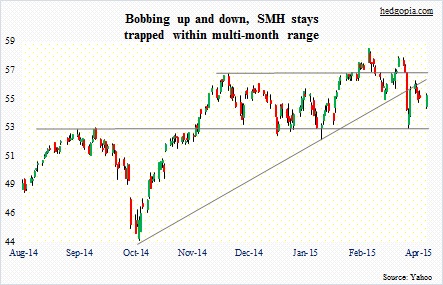SMH, the semiconductor ETF, has been range-bound since last September. Looking at a weekly chart (the one below is daily), the path of least resistance seems down in the medium-term. Bears had a great opportunity seven sessions ago to push it through the bottom of the range, but once again bulls regrouped. The subsequent rally has the ETF predictably find resistance at the underside of a broken trendline.
The message in all this is that both the bulls and bears are not ready to give up easy – for now. They are holding on to their turf.
Near-term outlook increasingly looks neutral. 1Q earnings estimates have come down for some U.S. chipmakers, but not for others.
Of the major U.S.-listed chipmakers, only INTC (April 14th) and SNDK (April 15th) would have reported by the 17th, when April options expire. They have both already cut 1Q guidance, so there probably is not much room for surprise. TXN, QCOM and XLNX report on the 22nd, ALTR on the 23rd, and BRCM on the 21st.
This could be setting up well for neutral option strategies. One such is iron condor, which involves four different options with four different strikes but with same expiration.
Here is an example on SMH (55.05), using April options:
Long 57 call for $0.25
Short 56 call for $0.58
Short 53 put for $0.35
Long 52 put for $0.18
This nets a credit of $0.50.
These are essentially two strangles – short 56 call and 53 put in the middle, and long 57 call and 52 put on the wings. We can look at it another way, which is that it combines two credit spreads – a bear call spread (long 57 and short 56) and a bull put spread (short 53 and long 52).
By the way, this is a traditional way of doing an iron condor. One can also leg into it, after first establishing one leg and then waiting for an opportunity to do the second.
The strategy limits both possible gain and loss. And that is the idea – try to capture the premium expecting a sideways move in the underlying. In the cited example, the best possible outcome is if SMH closes between 56 and 53 in the next nine sessions. If it moves over 57 or below 52, maximum possible loss is $0.50. Both maximum loss and gain are capped.

